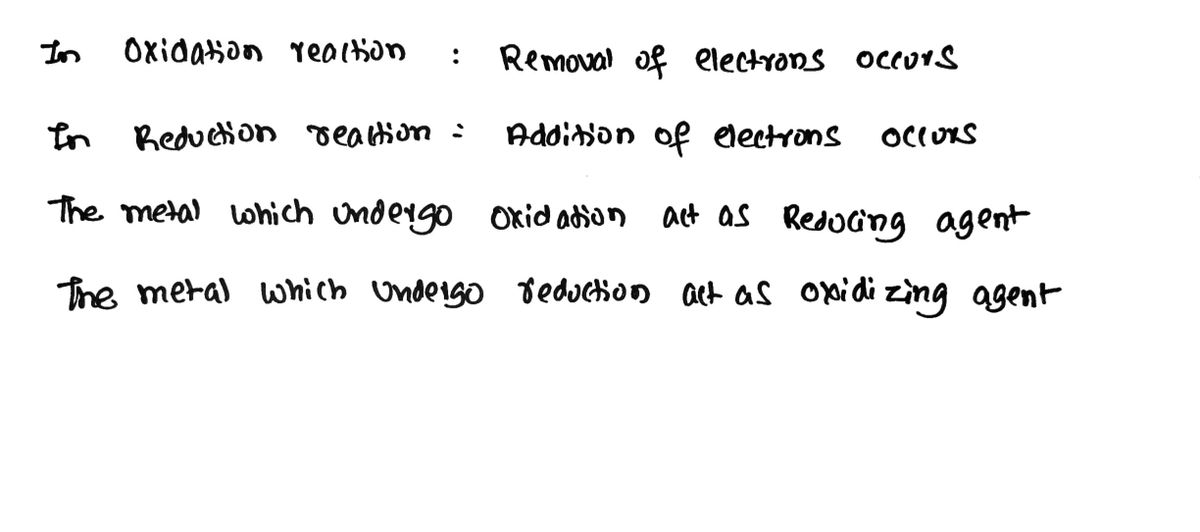Identify the species oxidized, the species reduced, the oxidizing agent and the reducing agent in the following electron-transfer reaction. Pb2*(aq) + Sn(s) –→ Pb(s) + Sn²*(aq) species oxidized species reduced oxidizing agent reducing agent As the reaction proceeds, electrons are transferred from to
Identify the species oxidized, the species reduced, the oxidizing agent and the reducing agent in the following electron-transfer reaction. Pb2*(aq) + Sn(s) –→ Pb(s) + Sn²*(aq) species oxidized species reduced oxidizing agent reducing agent As the reaction proceeds, electrons are transferred from to
Chemistry
10th Edition
ISBN:9781305957404
Author:Steven S. Zumdahl, Susan A. Zumdahl, Donald J. DeCoste
Publisher:Steven S. Zumdahl, Susan A. Zumdahl, Donald J. DeCoste
Chapter1: Chemical Foundations
Section: Chapter Questions
Problem 1RQ: Define and explain the differences between the following terms. a. law and theory b. theory and...
Related questions
Question
![**Identifying Oxidation and Reduction in an Electron-Transfer Reaction**
The following reaction illustrates an electron-transfer process:
\[ \text{Pb}^{2+}(\text{aq}) + \text{Sn}(\text{s}) \rightarrow \text{Pb}(\text{s}) + \text{Sn}^{2+}(\text{aq}) \]
**Task:**
Identify the following in the reaction above:
- **Species Oxidized:**
Determine which element loses electrons during the reaction.
- **Species Reduced:**
Identify the element that gains electrons.
- **Oxidizing Agent:**
Find the species that facilitates oxidation by gaining electrons.
- **Reducing Agent:**
Identify the species that donates electrons, thus facilitating reduction.
**Electron Transfer:**
Consider the flow of electrons as the reaction proceeds. Electrons are transferred from the reducing agent to the oxidizing agent. Indicate the direction of this electron transfer in the spaces provided.
As the reaction proceeds, electrons are transferred from the _______ to the _______.](/v2/_next/image?url=https%3A%2F%2Fcontent.bartleby.com%2Fqna-images%2Fquestion%2Fa0450cc9-9104-456b-91ad-505da73c8865%2F7cf3de14-6af6-4510-86b8-73443149d7dd%2Fhq0q9c_processed.png&w=3840&q=75)
Transcribed Image Text:**Identifying Oxidation and Reduction in an Electron-Transfer Reaction**
The following reaction illustrates an electron-transfer process:
\[ \text{Pb}^{2+}(\text{aq}) + \text{Sn}(\text{s}) \rightarrow \text{Pb}(\text{s}) + \text{Sn}^{2+}(\text{aq}) \]
**Task:**
Identify the following in the reaction above:
- **Species Oxidized:**
Determine which element loses electrons during the reaction.
- **Species Reduced:**
Identify the element that gains electrons.
- **Oxidizing Agent:**
Find the species that facilitates oxidation by gaining electrons.
- **Reducing Agent:**
Identify the species that donates electrons, thus facilitating reduction.
**Electron Transfer:**
Consider the flow of electrons as the reaction proceeds. Electrons are transferred from the reducing agent to the oxidizing agent. Indicate the direction of this electron transfer in the spaces provided.
As the reaction proceeds, electrons are transferred from the _______ to the _______.

Transcribed Image Text:The compound *silver nitrate*, AgNO₃, is soluble in water. Write the net ionic equation for the dissociation reaction that occurs when solid silver nitrate dissolves in water:
Be sure to specify states such as (aq) or (s).
Diagram Description:
- The diagram is an equation depicting the dissociation process.
- A box represents solid silver nitrate on the left side, transformed by water (H₂O) as indicated by an arrow pointing to the right.
- To the right of the arrow, there are two boxes representing the dissociated ions as products.
The silver nitrate dissociation in water leads to the formation of silver (Ag⁺) ions and nitrate (NO₃⁻) ions, each in aqueous form.
Expert Solution
Step 1

Step by step
Solved in 2 steps with 3 images

Recommended textbooks for you

Chemistry
Chemistry
ISBN:
9781305957404
Author:
Steven S. Zumdahl, Susan A. Zumdahl, Donald J. DeCoste
Publisher:
Cengage Learning

Chemistry
Chemistry
ISBN:
9781259911156
Author:
Raymond Chang Dr., Jason Overby Professor
Publisher:
McGraw-Hill Education

Principles of Instrumental Analysis
Chemistry
ISBN:
9781305577213
Author:
Douglas A. Skoog, F. James Holler, Stanley R. Crouch
Publisher:
Cengage Learning

Chemistry
Chemistry
ISBN:
9781305957404
Author:
Steven S. Zumdahl, Susan A. Zumdahl, Donald J. DeCoste
Publisher:
Cengage Learning

Chemistry
Chemistry
ISBN:
9781259911156
Author:
Raymond Chang Dr., Jason Overby Professor
Publisher:
McGraw-Hill Education

Principles of Instrumental Analysis
Chemistry
ISBN:
9781305577213
Author:
Douglas A. Skoog, F. James Holler, Stanley R. Crouch
Publisher:
Cengage Learning

Organic Chemistry
Chemistry
ISBN:
9780078021558
Author:
Janice Gorzynski Smith Dr.
Publisher:
McGraw-Hill Education

Chemistry: Principles and Reactions
Chemistry
ISBN:
9781305079373
Author:
William L. Masterton, Cecile N. Hurley
Publisher:
Cengage Learning

Elementary Principles of Chemical Processes, Bind…
Chemistry
ISBN:
9781118431221
Author:
Richard M. Felder, Ronald W. Rousseau, Lisa G. Bullard
Publisher:
WILEY